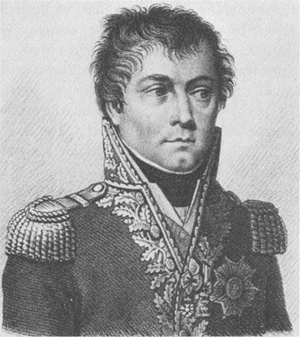General Antoine François Andreossy

Born: March 6, 1761
Place of Birth: Castelnaudary, Aude, France
Died: September 10, 1828
Cause of Death: Illness
Place of Death: Montauban, France
Arc de Triomphe: ANDREOSSI on the south pillar
Pronunciation:
Born into a noble family, Antoine François Andreossy began his military career by enrolling in the artillery school of Metz. In 1781 he was commissioned as a lieutenant in the artillery regiment of Auxonne. Six years later in 1787 Andreossy was serving in Holland when he was taken prisoner by the Prussians, but he was exchanged before long. The next year he was promoted to capitaine.
With the arrival of the French Revolution, in 1792 and 1793 Captain Andreossy served with the Army of the Moselle. 1794 saw him joining the Army of Italy where he became director of the artillery park of the advance guard. The next year he received a promotion to chef de bataillon. In 1796 when General Napoleon Bonaparte assumed command of the Army of Italy, Andreossy was selected to be the deputy director of the bridging train. Andreossy served at the crossing of the Po River on May 7th, and then at the start of June he became director of the bridging train. With the French army laying siege to Mantua, in July Bonaparte specifically selected Andreossy to command five gunboats to make a diversionary attack against Mantua while other units attacked. Andreossy then returned to the bridging train, and in November he and his men laid a bridge over the Adige at Ronco, helping to set up the Battle of Arcola . For his successful work, he was promoted to chef de brigade that December. In 1797 Andreossy served at the crossing of the Isonzo and at the action of Gradisca, and in November he was promoted to général de brigade.
Andreossy was next designated for the Army of the Orient and once again he was made director of the bridging train. He also became a member of the Institute of Egypt. In July of 1798 he commanded the troops of the flotilla on the Nile and he distinguished himself fighting at Chébreiss. Next Andreossy was ordered to explore Lake Menzaleh with a flotilla and then in September he fought at El-Schouara. In February of 1799 he became an assistant to the chief of staff General Berthier. When Napoleon decided to leave Egypt and return to France, Andreossy was one of the select few chosen to accompany him.
Back in France, Andreossy served as Napoleon's chief of staff during the coup of 18 Brumaire and then in early January of 1800 he was promoted to général de division. He next took command of the artillery at Strasbourg and then later the artillery at Mainz, and then he became an inspector general of artillery. In 1802 Andreossy was sent as ambassador to England and he was recalled in 1803. For the campaign of 1805 he served on the staff of the Grande Armée. His next diplomatic role came in November of 1806 when he became ambassador to Austria. In 1809 Andreossy was made a Count of the Empire and later that year he became governor of Vienna when the French army arrived during the Danube campaign that year. A few months later he received the Grand Eagle of the Legion of Honor.
In 1810 Andreossy became a member of the Council of State and he continued in that role until 1812 when he was named ambassador to the Ottoman Empire. After Napoleon's abdication in 1814, Andreossy was recalled to France but he was also named a Knight of Saint Louis. When in 1815 Napoleon returned from exile for the Hundred Days, he named Andreossy a Peer of France and gave him command of the 1st military division. After the French loss at Waterloo, Andreossy was sent to negotiate with Wellington, probably due to his fluency in English.
In 1824 Andreossy became a member of the Academy of Sciences and in 1827 he was elected a liberal deputy of Aude. Over the course of his life he published a number of scientific papers.
Bibliography
- Chandler, David G. Dictionary of the Napoleonic Wars. New York: Macmillan Publishing, 1979.
- Divry, Arnauld. Les Noms Gravés sur l'Arc de Triomphe. Paris: L'Harmattan, 2017.
- Haythornthwaite, Philip J. Who Was Who in the Napoleonic Wars. London: Arms & Armour, 1998.
- Six, Georges. Dictionnaire Biographique des Généraux & Amiraux Français de la Révolution et de l'Empire (1792-1814). 2 vols. Paris: Gaston Saffroy, 2003.
External Links:
Updated September 2024
© Nathan D. Jensen